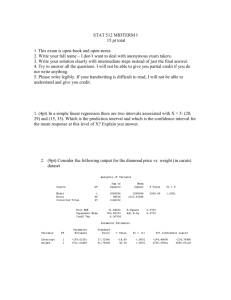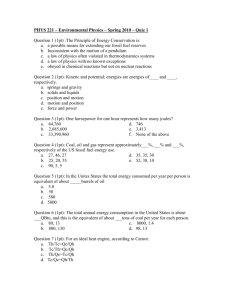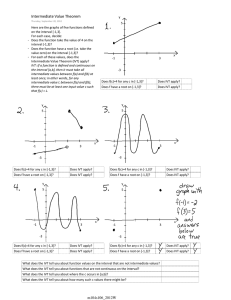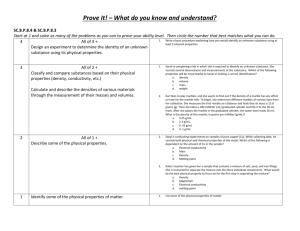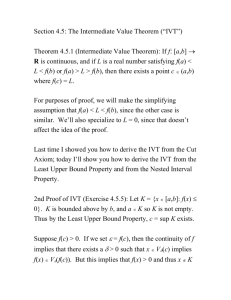FRQs1-Rates-IVT-Derivatives
advertisement
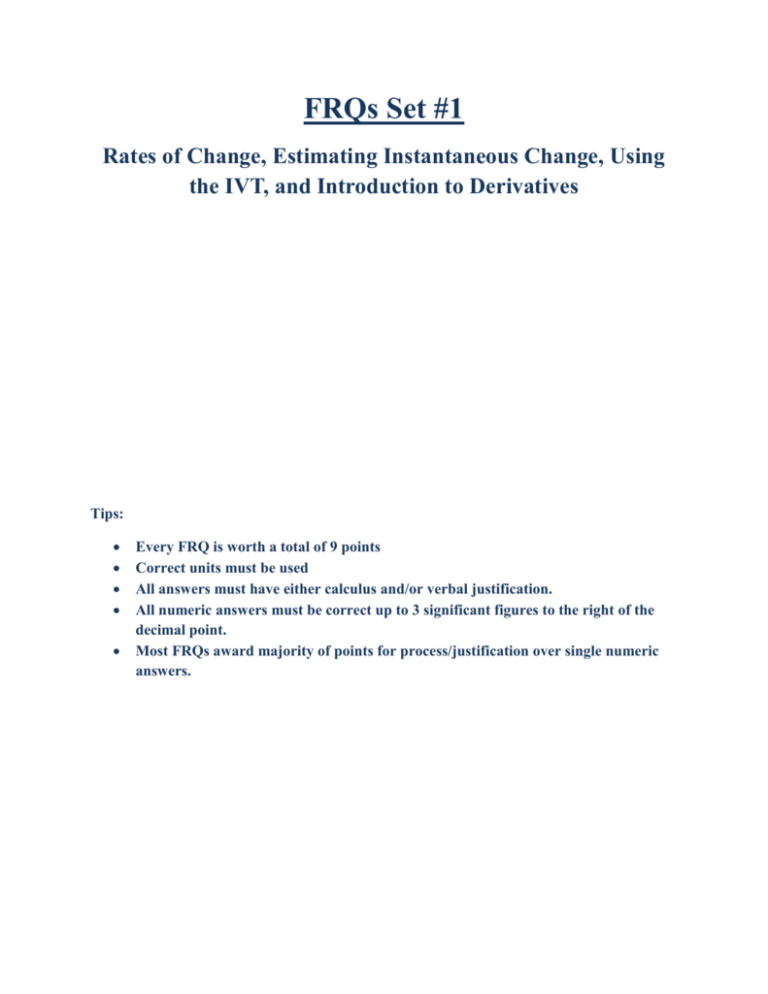
FRQs Set #1 Rates of Change, Estimating Instantaneous Change, Using the IVT, and Introduction to Derivatives Tips: Every FRQ is worth a total of 9 points Correct units must be used All answers must have either calculus and/or verbal justification. All numeric answers must be correct up to 3 significant figures to the right of the decimal point. Most FRQs award majority of points for process/justification over single numeric answers. FRQ1 – Estimating Instantaneous Change Calculator Active The velocity of a particle moving along the x-axis is given by the following graph and table, where t is the time in seconds and v(t) is the velocity in centimeters per second. a. Estimate the rate of change in the velocity (i.e. the acceleration) of the particle when t = 30. Indicate the units. b. Use your answer from part (a) to approximate the velocity of the particle when t = 31. Indicate the units. c. Does the particle ever change direction? If so, at what time(s)? Justify your answer. d. Mike Boardman concludes that since the slope of the secant line joining the point (0, 1) to the point (30, -1) is negative, the particle must have been decelerating over the entire interval from t = 0 to t = 30. Is Mike correct? Give reasons for your answer drawn from the graph or the table. FRQ 2 –IVT and Linear Approximation (Calculator Active) A marble is released on an inclined table. The distance the marble rolls over a given time interval is then measured. The table below gives various values of s(t), the distance the marble is away from where it was released (measured in inches) as a function of time t, measured in seconds from the moment the marble was released. t s(t) 0 0 2 1.5 4 6 6 13.5 8 24 10 37.5 a. Find the average rate at which the marble is rolling during the time interval t = 4 to t = 10. Show the computations that lead to your answer. Indicate units of measure. b. Estimate the instantaneous rate at which the marble is rolling at t = 6 seconds. Show the computations that lead to your answer. Indicate units of measure. c. Must there be a time when the marble has rolled exactly 10 inches? Justify your answer. d. The data in the table for s(t) is modeled by the function g(t) = 0.375t2. Use the definition of the derivative to find the equation of the tangent line to g(t) at t = 6 seconds. e. Use your answer from part (d) to estimate the distance the marble will have rolled at t = 6.2 seconds. Indicate units of measure. FRQ 3 – IVT and Continuity Calculator Active This is a calculator active question. Given the function g(x) defined so that: a. Verify that if k = 5, the Intermediate Value Theorem applies to g(x) on the closed interval [2, 3], and predicts that g(x)has at least one root on that interval. Find that root. b. Find k so that g(x) is a continuous function. c. For the value of k found in part (b), evaluate . If it does not exist, so state and explain why. d. For the value of k found in part (b), evaluate g ' (1). If it does not exist, so state and explain why. FRQ 1 Standard: FRQ 2 Standard: a. (37.5 - 6)/(10 - 4) = 5.25 inches/second 1pt: answer based on evidence b. (24 - 6)/(8 - 4) = 4.5 inches/second OR (24 - 13.5)/(8 - 6) = 5.25 1pt: answer based inches/second OR (13.5 - 6)/(6 - 4) = 3.75 inches/second on evidence c. Yes. Since marbles roll in a continuous fashion, s(t) must be a continuous 1pt: answer function on [0, 10]. Therefore, the IVT applies. Since s(4) < 10 and s(6) > 10, 1pt: appeal to the by the IVT there must be a value of c on [4, 6] where s(c) = 10. IVT d. g(6) = 13.5. 1pt: limit of difference quotient 1pt: g'(6) 1pt: equation Tangent line: y - 13.5 = 4.5(t - 6) e. Distance ≈4.5 (6.2 - 6) +13.5 = 14.4 inches 1pt: answer 1pt: units in parts a, b, and e. FRQ 3 Standard: a.If k = 5, g(x) = 5 - 2x on [2, 3]. Therefore, 1 pt. states g(x) is continous on the interval g(x) is continuous on [2, 3], so the IVT applies. Since g(2) = 5 - 2(2) = 1 > 0 and g(3) = 5 - 2(3) 1 pt. states g(a) > 0 and g(b) < 0 for some a, b = -1 < 0, by the IVT there must be at least one on [2, 3] root of g(x) on [2, 3]. 5 - 2x = 0, so x = 5/2. b. 12 + 2k = k - 2(1) k = -3 c. 12 + 2(-3) = -5 d. g ' (x) = 2x for x < 1 and g ' (x) = -2 for x ≥ 1. 1 pt. solves g(t) = 0 1 pt. sets two branches of g at x = 1 equal 1 pt. solves for k 1 pt. answer 1 pt: conclusion Since , g'(1) 1 pt: evaluates does not exist because the left- and right-handed limits of the difference quotient disagree. 1 pt: evaluates



